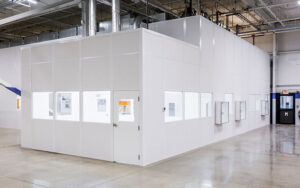More than a room that is clean or a controlled environment, according to the ISO standard 14644-1 clean room definition, a clean room is defined as:
“A room in which the concentration of airborne particles is controlled, and which is constructed and used in a manner to minimize the introduction, generation, and retention of particles inside the room and in which other relevant parameters, e.g., temperature, humidity, and pressure, are controlled as necessary”
Minimizing the introduction, generation and retention of particles in a clean room is done in 3 ways:
- Supplying the room with a large quantity of air filtered with HEPA (High Efficiency Particulate Air) filters. The filtered air will dilute and remove particles, bacteria and chemicals from within the room. The air is used to pressurize the room and ensure a non-contaminated clean room air circulation
- The clean room itself must be built with materials that do not generate contaminants, particles, or outgas airborne chemical and must also be easy to clean.
- Clean room operators must wear garments that minimize dispersion of particles and micro-organisms generated by people such as hair, skin flakes, clothing fibers, etc. In fact, operator base contamination accounts for 70% to 80% of cleanroom contamination. To minimize the risk of contamination, the clean room operators will usually get dressed in a gowning room, also referred as anteroom.
HOW DOES IT WORK?
Cleanrooms work to remove particles and contaminants from outside ambient air. Outside air is circulated to a filter system. The filter system is typically a ceiling placed fan filter unit(s). The filters then clean and decontaminate this outside air according to their specifications. The filtered air is then forced into the cleanroom. Additionally, contaminated air within the cleanroom is forced outside the room by registers, or it is recirculated back into the filters, and the process restarts.
WHO NEEDS A CLEANROOM?
There are a wide variety of reasons that a company may need a cleanroom. If you’re manufacturing something that is easily affected by contaminants or particles in the air for example, it’s likely that you’ll need a cleanroom. If you’re not sure, or if you’d like an estimate, give the experts at Angstrom a call. Here are a few common reasons you might need a cleanroom, and some common industries that regularly use cleanrooms:
- Manufacturing Companies
- Research Facilities
- Pharmaceutical Companies
- Medical Laboratories
- Electronic Part Production
- Cannabis Labs
- Aerospace Industry
- Nanotechnology production
- Optics and Lens Manufacturing
- Military Applications

Recent Comments